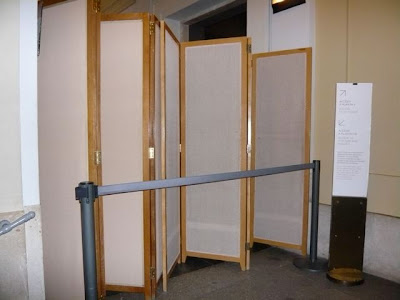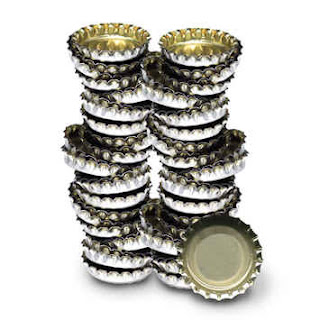
“I love it all. I love you, for what you do not love, what you throw away. There’s a sad paradox in that. I love you for your lack of love for what I love.”
William Davies King is a professor of theatre at the University of California who can’t throw things away. His collection includes 18,000 food labels, 500 bottle caps and 800 distinct envelope linings. As King wistfully comments in his book Collections of Nothing, “I dearly want my collecting to be a selling point, like a mountain cabin ... or Goya prints… instead, I have to anticipate [my wife] coming to terms with 30 years of Cheerios.”
Thursday, July 31, 2008
Warning to collectors
Posted by
jim and Mary
at
11:59 AM
![]()
![]()
Labels: collecting, warning to collectors
Too cool for school

Janet Frame’s short story A Night at the Opera was published in a recent (2 June) issue of The New Yorker. The story is generally reckoned to have been written in 1954 shortly after Frame had been a patient in the Avondale Psychiatric Hospital. A Night at the Opera is set in Park House, which was part of Auckland’s Whau Mental Hospital, later known as Carrington Hospital and now the UNITEC campus. Frame describes Park House as being “squatted directly opposite the door of the hospital kitchen, like a dirty brick imbecile waiting for its food.” The current inmates of Park House are UNITEC art students. It also served as a recording studio for Flying Nun’s band the Abel Tasmans when they recorded their fourth album, Store in a Cool Place.
Image: The Marx Brothers go crazy in their movie A Night at the Opera
Posted by
jim and Mary
at
7:08 AM
![]()
![]()
Labels: art school
Wednesday, July 30, 2008
Good luck
For the next year the Head of School at Elam (the University of Auckland’s Art School) will be Nuala Gregory. According to the University web site Nuala is interested in “the conjunction medium-technology-painting, (non-)representation in art, and the scholarship of creative practice in higher degree research.” Her own art works are “presentations of inchoate form in high-keyed colour; they are intended to invite visual attention from the viewer rather than reduce to represented meaning. As such, they may be seen as exercises in fidelity to the opticality of visual art, or equally as a theoretical-practical enquiry into the condition of painting practice in the age of 'post-medium' and even 'post-conceptual' art.”
Lest we forget
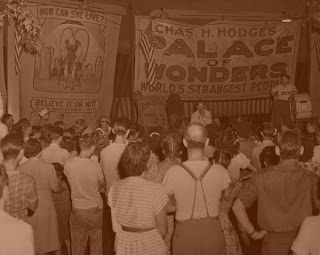
“… this iconic and much-loved New Zealand artist."
“… one of New Zealand’s best-loved artists. “
“… New Zealand’s favourite artist. ”
“… one of this country’s pioneer modern painters. “
“… this remarkable artist. “
“… one of New Zealand’s most significant artists. “
Te Papa pitches Rita Angus on its web site
Tuesday, July 29, 2008
Saint Bernard
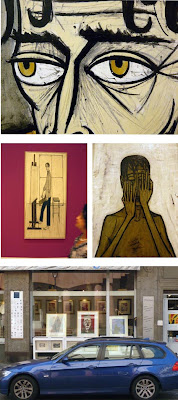
Some years ago we were keen to curate an exhibition looking at the history of popular art in New Zealand. As part of the research we discovered a fascinating resource. The catalogues of ‘original prints’ ordered by framing shops from overseas publishers. (That term ‘original print’ would continue to haunt New Zealand print makers for many years). Some of the catalogues were annotated with orders and so our collection gave us a pretty good picture of the good pretty pictures that ended up on New Zealand walls. In the fifties and sixties there weren’t many original contemporary art works to be found in New Zealand homes but two contemporary international artists were household names – Pablo Picasso and Bernard Buffet. When in Frankfurt a couple of days ago, we had to head straight for the Bernard Buffet survey at the Museum fur Moderne Kunst. This was the latest of a number of attempts to revive Buffet from the contemporary art benches he has warmed for most of the last 40 years. It is hard to remember now how influential Buffet’s soulful expressionistic figures and dark jagged-lines were on a whole era of graphic style. Today they seem hammy and overwrought, but there was a time when for many people a Bernard Buffet print in the living room showed an appreciation of what was modern in the world. The curator of the Frankfurt show describes Buffet’s low standing with contemporary art critics and curators as ‘suppression’ but when you looked at the work that assertion didn’t ring true. Buffet’s genre narratives still look like illustrations of someone else’s ideas and the curator, by also hanging some great Andy Warhol paintings alongside the Buffets (Warhol said something nice about him once – it was that kind of show) was, albeit unintentionally, putting the boot in. The question that occupied us was why Buffet, who was so richly rewarded, influential and world-famous, still felt so unappreciated?
Images: Top and middle Bernard Buffet details and Self Portrait. Bottom Buffet print on sale opposite the Museum fur Moderne Kunst.
Posted by
jim and Mary
at
7:00 AM
![]()
![]()
Monday, July 28, 2008
Busy body
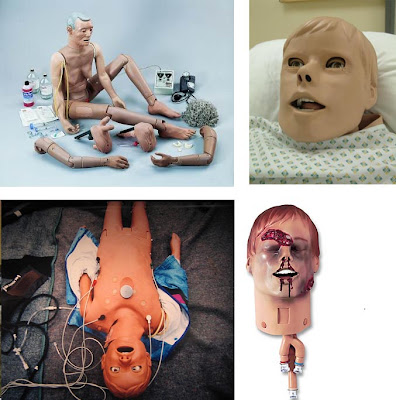
When we saw these medical mannequins on Boing Boing we immediately thought of works by Charles Ray, Gillian Wearing, Paul McCarthy and Ronnie van Hout. Wonderful, but creepy.
Posted by
jim and Mary
at
7:00 AM
![]()
![]()
Wednesday, July 23, 2008
Flying South for the Winter
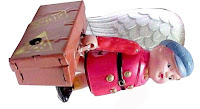 We won't be posting for a couple of days while we wait in airports, walk around in our socks, and carry our liquids in plastic bags. Back on Monday.
We won't be posting for a couple of days while we wait in airports, walk around in our socks, and carry our liquids in plastic bags. Back on Monday.
Posted by
jim and Mary
at
11:54 AM
![]()
![]()
Bagged
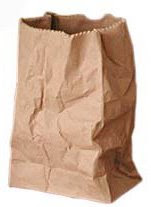
This from CNZ Chairman Alastair Carruthers speaking to The 21st Century Arts Conference in Auckland.
“The key lies not in dumbing down the arts but in demystifying access to them while retaining their sense of wonder. We must drop impenetrable artistic pretension and help new audiences realise that they don’t need classical training or a secret code before they can "get it". (our italics)
In the speech Carruthers uses three examples where ‘artistic pretension’ has been dropped and, consequently, new audiences won over by works of excellence. The first example was from music, with a highbrow Baroque orchestra concert saved by an unusual and memorable presentation. The second an interactive light show on the walls of Te Papa by Rafael Lozano-Hemmer, “I watched people young and old squeal with delight.”
His third example is Doris Salcedo’s installation Shibboleth at the Tate which we posted on last year. After quoting the Guardian and the artist as background, Carruther’s adds his own undercutting, “So that's the idea. (If you can get it.)” This is followed by quoting an anonymous reporter, who declared of the work, “This being The Tate, we also feel obliged, finally, to consider the possibility that it might be art. No one, in short, has the slightest clue." His final quote is from a builder who happened to be working in the Tate at the time of the installation “…I'm not much of a one for modern art. It was a pretty good trench, though. And one hell of a lot of cement. Good luck to 'em." Thanks Alistair.
You can read Excellence and Engagement: speech to the 21st century arts conference on 26 June 2008 by Alastair Carruthers, Arts Council Chair, Creative New Zealand here.
Tuesday, July 22, 2008
Blow me up, blow me down
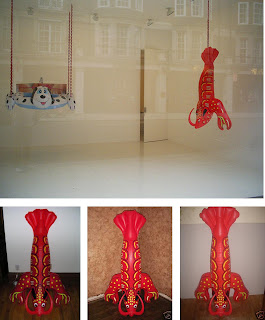
You can’t keep a good art entrepreneur down, and when it comes to Jeff Koons they exceed expectations. Now available on eBay is one of the original inflatables that Koons used to cast his painted aluminium sculpture Lobster. You can pick up your plastic Lobster Rider here for $39.99 or search for “Jeff Koons Lobster” on eBay for a bargain price.
Images: Top, the Koons copy on exhibition at Gagosian. Bottom, originals for sale on eBay
Posted by
jim and Mary
at
7:01 AM
![]()
![]()
Labels: koons, Look alike
Monday, July 21, 2008
The long and the short of it
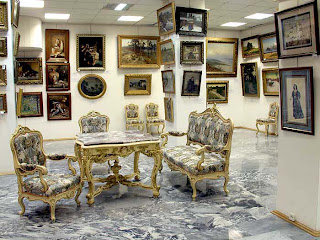
“For a collector – and I mean a real collector, a collector as he ought to be – ownership is the most intimate relationship that anyone can have to objects. Not that they come alive to him; it is he who lives in them.” - Walter Benjamin
“I have at times come across my work at parties in the homes of wealthy people; misplaced and mute as a stuffed bird or bear, it seems to function there as a trophy acquired in a foreign land, as if it had been bagged during an art safari.” - Artist, Fred Wilson
Quoted by Minnie Scott in her essay Collecting Ourselves in the Whitney publication The Price of Everything: Perspectives on the Art Market
Image: The first image to come up in Google Images on the words “Art Collection” - the Gelos Auction House
Posted by
jim and Mary
at
11:59 AM
![]()
![]()
Labels: collecting
You’re know you’re soaking in it

We mentioned Franz West earlier in the week. In the applied arts museum MAK in Vienna we saw a show of West’s furniture called Sit on my chair. Lay on my bed. There was a provocation in there as to whether the work was supposed to be art or furniture but the price tells the tale. It’s art. And you can’t sit or lie on anything in the show (although you can do both on the couches seen in the images above that are in the MAK foyer). So we started thinking about an art collection that only included things you would find in the home. An art collection that might be invisible to many people. Our nominations.
Chairs – Franz West
Lamps – Jorge Pardo
Shelving – Haim Steinbach
Windows – Ralph Hotere
Blinds – et al.
Doors – Louise Bourgeois
Condiments – Paul McCarthy
Flooring – Fiona Connor
Tableware – Judy Chicago
Maybe we’ve been away too long.
Images: Franz West couches at MAK in Vienna
Posted by
jim and Mary
at
7:00 AM
![]()
![]()
Saturday, July 19, 2008
Art is where you find it
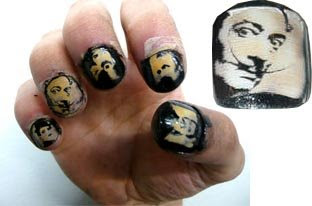
If you thought the molar thing was a bit too subtle (how long can you keep your mouth open at a party?) for you, how about painted and laser-etched art on finger nails? And yes, there’s a how-to video.
Posted by
jim and Mary
at
7:00 AM
![]()
![]()
Labels: Art is where you find it
Friday, July 18, 2008
Wrendering

More on virtual buildings, this one covering up St Paul’s Cathedral in London, back in 2003. The drawing is a blow-up of Sir Christopher Wren’s original charcoal study of the façade of the cathedral that started its 33 year building programme in 1675. Thanks RS.
Posted by
jim and Mary
at
2:44 PM
![]()
![]()
Labels: architecture
Lifestyle section
Spam (International edition)

reckless guesswork, insinuations and possible inventions that have arrived at overthenet.blog@gmail.com: all things come to those who wait. welcome news that billy apple has been ear-marked for a significant survey exhibition at the witte de with center for contemporary art in rotterdam. apple was invited by director nicolaus schafhausen who is also commissioner for the german pavilion at venice. schafhausen has visited new zealand a number of times and continues to be an influential advocate of nz artists. as one of the curators of the first brussels biennial (florian waldvogel is the other one) he has invited simon denny and et al to participate. et al’s. invitation apparently comes after their basel showing. given the lack of follow-up opportunities from our showings at venice cnz might look harder at art fairs as a way to attract the attention of international curators. any missed details, indignant denials or additions gratefully received, and the most surprising, rewarded with an international edition overthenet cap.
Thursday, July 17, 2008
On the road
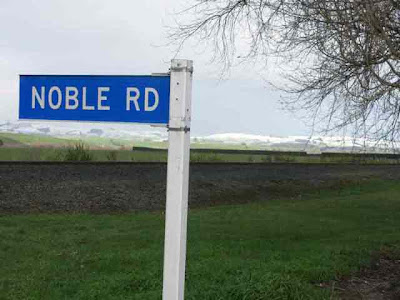
On the road is an ongoing series celebrating the Ministry of Land Transport and Local Body support of New Zealand artists. For others in the series search 'on the road' on the blog search above. Thanks P.
Posted by
jim and Mary
at
11:59 AM
![]()
![]()
Labels: on the road
Get real
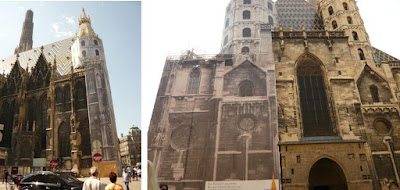
We saw an extension of the virtual building thing in Vienna and the biggest photograph we’ve ever seen. About a sixth of St Stephen’s Cathedral was covered by this photograph presumably to remind people what was underneath it while it was being repaired. This is different from the first example we saw where the photograph suggested what a new building might look like in the location. The cathedral photograph serves another purpose. It’s not conjecture but the presentation of some weird kind of reality check. It reminds us of a slide Joseph Kosuth showed when he spoke at Victoria University a few years ago. It was a work he did in 1965 that exhibited a chair, the description of the chair (as a text pinned to the wall) and the photo of the chair. No doubt about it, Kosuth would be right on to the cathedral thing.
Posted by
jim and Mary
at
7:00 AM
![]()
![]()
Labels: architecture, photography
Wednesday, July 16, 2008
How Dare You David Shrigley
How
Dare
You
David
Shrigley
Over at stimulus--response is a flash animation concerning the presumptuous David Shrigley. That is all.
Posted by
Pippin
at
12:28 PM
![]()
![]()
Labels: stimulusresponse
Warning, warning, Will Robinson
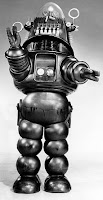
If elected a National Government will:
“Reform the Arts Council to improve service delivery.”
“Require all state funding agencies to be far more focused on artists and their needs.”
National Party Arts, Culture and Heritage spokesman Chris Finlayson
Posted by
jim and Mary
at
9:15 AM
![]()
![]()
Genuine oil
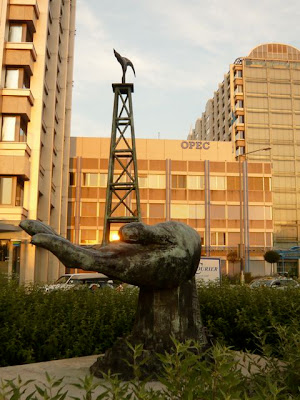
We work hard to make this blog relevant to the shifting and ruptures of the global economy. When the US sneezes Overthenet reaches for a tissue. So it was right up our alley when two of our great concerns, the international oil crisis and public sculpture, stepped out hand-in-hand in Vienna. This bronze sculpture from happier times is by the Venezuelan artist Paul del Rio, and is optimistically titled Mano Mineral. It sits outside the OPEC building in Vienna, the city where international oil prices are struck by the lucky ones who own it all.
Having just been through World Cup fever over here (we were in Madrid the day before Spain won the cup and in Germany the day it was defeated by the Spanish) we also interested to find that it was del Rio, wearing his revolutionary cap, and as a member of extremist group, the National Liberation Army Front, who kidnapped Alfredo di Stefano the Argentinean soccer star in 1963. Stefano who was on a South American tour with Real Madrid was taken at gun point, held for two days, and released unharmed.
Posted by
jim and Mary
at
7:02 AM
![]()
![]()
Labels: oil crisis, public sculpture
Tuesday, July 15, 2008
That’s incredible …. my watch has stopped too

A while back we removed a sidebar on Over The Net that pointed out that the Colin McCahon Database “published by the Museum of New Zealand, Te Papa Tongarewa” was in a sad state of repair. Jonathan Mane-Wheoki, the head of art at Te Papa, had publicly promised to fix the database in a Te Papa newsletter and, when we checked, they had indeed made a start and corrected one entry. That was over five months ago and, as far as we can see, nothing more has happened. The other four mistakes we listed (and there will be more) on a quick flick through the site remain, as does the six-year-old promise that “A Selection of essays on Colin McCahon's life and work is currently in development and will be available soon.” There is still not a single essay, however, to be seen. Realistically the McCahon Database could be dramatically improved by an MA student in a couple of months. When Mane-Wheoki said Te Papa had been “planning for two years” to make a “modest upgrade” you might have reasonably assumed that "modest" meant more than spending five months to correct one typo.
Monday, July 14, 2008
When ads use art
 We have posted before about the uneasy relationship between advertising and art. Anyone who found that interesting will enjoy this article by Mia Fineman from the New York Times outlining some recent cases and a bit of history.
We have posted before about the uneasy relationship between advertising and art. Anyone who found that interesting will enjoy this article by Mia Fineman from the New York Times outlining some recent cases and a bit of history.
Posted by
jim and Mary
at
9:07 AM
![]()
![]()
Labels: when ads follow art
Go West

We’re big fans of Franz West, the Austrian artist who lives in Vienna. The work is amazing but we’re also very interested in the way he has built an international career without leaving his home town. In the late 60s in New Zealand the famous art critic Clement Greenberg proclaimed that he didn’t believe a great art work of international importance could ever be made in a country as small and as isolated as New Zealand. At the time it felt like American arrogance, but many of the new generation of NZ artists evidently feel the same judging by the amount of time they spend out of the country. No doubt at the time Greenberg would have made the same assessment of Austria, so Franz West has always been a bit of a finger in the eye to the grouchy old Yank. We don't know what West’s secret is, but suspect it has something to do with productivity and his process as well as the extraordinary qualities of Vienna. The latest issue of Spike has a revealing interview with him by Andreas Reiter Raabe with West discussing his process. West’s work is made with the help of many assistants and we got to see lots of his chairs, tables, cupboards, lamps etc at MAK as well a new lamp in a Viennese collector’s apartment. When we were shown into the living room to see the lamp, next to it was a work by Simon Denny. It was a strange sensation looking out over the Viennese skyline with these two works beside us.
Image: Left Simon Denny Untitled (Green ties) and right a lamp by Franz West
Posted by
jim and Mary
at
7:05 AM
![]()
![]()
Saturday, July 12, 2008
Hitler studies
Having lost his head it's Adolf's week on Over The Net. A bit off brand but movies are art too, and it will make a very, very funny start to your Saturday.
Posted by
jim and Mary
at
7:05 PM
![]()
![]()
Friday, July 11, 2008
On the Road

On the road is an ongoing series celebrating the Ministry of Land Transport and Local Body support of New Zealand artists. For others in the series search 'on the road' on the blog search above.
Posted by
jim and Mary
at
11:30 AM
![]()
![]()
Labels: on the road
Guess who’s coming to dinner?
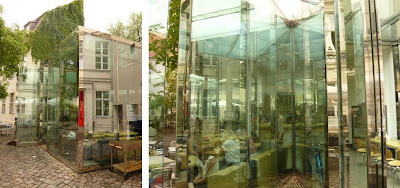
Some time back in the early eighties Wystan Curnow called to ask if we could have a visiting American artist to stay for few days. The artist turned out to be Dan Graham. He arrived, shuffled around the house a bit, and then sat down at the kitchen table where he pretty much stayed for the whole time he was with us. Dan had a way of mumbling that made it quite hard to hear what he was saying so, as the days passed, we found ourselves sitting closer and closer to him.
As someone who had been at the centre of the development of conceptual art he knew a lot people but sometimes it was tough to work out who he was talking about. For instance, was the Benjamin he was quoting Buchloh or Walter? It was a bit more obvious one morning when Dan asked us to mail some postcards. They were addressed to a who’s who of conceptual and minimal art. “Dear Sol”, “Hi Carl”, “What d’ya know Joe, I’m in Wellington New Zealand.”
We only side-tracked Dan from art and philosophy once. We were at City Limits and when his hamburger arrived he lifted the bun to find the meat patty covered in bean sprouts. There was not a word from him for about five long minutes. We were thinking about those days when we had coffee in a pavilion that Dan Graham designed for the KW Institute for Art. It was reflective, complex, and practical, just like Dan Graham himself. Thanks Wystan.
Images: Dan Graham's cafe installation at KW
Posted by
jim and Mary
at
7:00 AM
![]()
![]()
Labels: public sculpture
Thursday, July 10, 2008
Icon
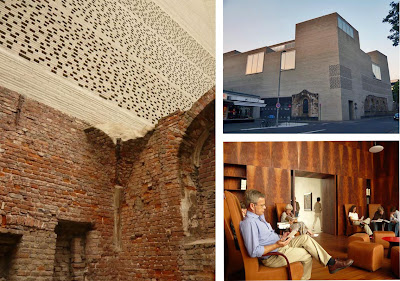
The relationship between architects and the artworks in contemporary museums is often not a happy one. The buildings are often either eccentric spaces decorated with the architect’s own idiosyncratic interventions (the Adam with its cut-away mezzanine, the New in Auckland with its awkward spaces circling a void, and that diving board) or a couple of over-scaled, difficult spaces for the museum to fill as best it can (Te Papa and the City Gallery in Wellington). There have been some successes in New Zealand. Nick Stevenson’s Artspace is one, and the new Tauranga Art Gallery has had positive art-specific commentary and looks good in pictures. But over all, purpose-built art galleries designed to show art rather than show off the architect are rare anywhere in the world. Renzo Piano’s De Menil in Houston gets a tick from us but Zaha Hadid’s Contemporary Art Center in Cincinnati doesn’t. We’d give one to Tadao Ando’s Modern Art Museum in Fort Worth Texas but not to his Contemporary Art Museum in Naoshima, Japan. Some architects understand how to create spaces that enhance the experience of art, but they are rare. Now, having just visited Kolumba the art museum of the archbishopric of Cologne, we’d add Peter Zumthor to our select list.
Opened last year, Zumthor’s building partly surrounds the excavated foundations of the Gothic church St. Kolumba. This was a project with a lot of constraints from the outset. For this part of the construction, Zumthor extended the ruined walls of the old church into a delicate breeze block wall that lets traffic noise and weather drift into the high-ceilinged internal space. Breeze block sounds mundane but here the effect has faint echoes of Islamic filigree. The rest of the building is occupied by galleries and offices etc. The height of some galleries teeters on the extreme until it is brought into balance by the strange and wonderful mix of contemporary art and ecclesiastic relics. Most of the walls are painted and then rubbed pale grey although one space, featuring the Archbishopric’s treasures, is padded with black velvet (sounds cheesy but in fact achieves the sense of infinite space you get from a really good James Turrell along with great soundproofing). Zumthor seems to get the fundamentals of experience right every time. He truly think about us! From the luxury of the spectacular, wood-panelled library to the front door handles where the inside set are hand-bound with metal wire, the details are perfectly timed and realised. And for once, the building feels even better in life than it looks in photographs.
Images: Left, the ruined wall meets Zumthor’s breeze bricks. Right top, the building, bottom the reading room
Posted by
jim and Mary
at
7:10 AM
![]()
![]()
Labels: architecture
Wednesday, July 09, 2008
Bring in the clones
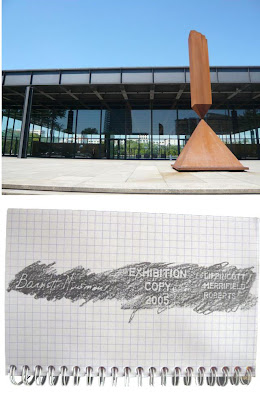
Barnett Newman’s sculpture Broken Obelisk was made in an edition of three. There is one currently on display at MoMA in New York, one standing outside the Rothko Chapel in Houston, one in the Red Square at Seattle’s Washington University and one outside the New National Gallery in Berlin.
It all started with Art and Space’s Google Earth based website. As we had just been to the New National Gallery we thought we’d attach photos of all the outdoor sculptures for the Google Earth view. Simple enough, until we checked on Google Earth and found that the large Barnett Newman Broken Obelisk on the plaza outside the front entrance wasn’t there. Of course this is one of the intriguing things about Google Earth. There are often long (sometimes years – the building that burnt down across the road from us in Wellington more than two years ago still stands on GE) gaps in the record making a big difference between what you see and what is actually there. This prompted us to check where the three editioned Broken Obelisks were situated, and that led in turn to THE FOURTH OBELISK.
The Berlin Obelisk is in fact an “Exhibition Copy”. This is revealed by a steel plate stuck on the sculpture’s base. The plate tell us that this copy was made in 2005 by Lippincott Merrifield Roberts, the fabrication business that also make Claes Oldenburg and Coosie van Bruggen’s sculptures. A Barnett Newman signature is also etched into the plate but as Newman died in 1970 it’s as hard to work out what the signature means in terms of the status of this copy. In 2004 MoMA’s version of Broken Obelisk was on loan to Berlin's New National Gallery. Maybe when it had to return to New York to feature in MoMA’s new building, Berlin pleaded for their own copy and …. got one.
Inevitably, as you start looking around, you find more examples of these “exhibition copies”, copies that are made because the original is too fragile or too valuable to travel and institutionally authorised in ways we haven’t been able to work out. Let the viewer beware appears to be the museum profession’s caveat. In the Berlin case the exhibition copy isn’t even in an exhibition, but the thought that there should only be three of an edition of three Barnett Newmans on exhibition at any one time has obviously become old think. The animals gathered round and there, written on the board for all of them to see, were the words, "Three broken obelisks good, four broken obelisks better."
Images: Top, Broken Obelisk on view in Berlin. Bottom, rubbing of the metal label attached to the Berlin copy.
Posted by
jim and Mary
at
7:01 AM
![]()
![]()
Labels: copy cat, Look alike, public sculpture
Tuesday, July 08, 2008
Question time

Daddy, what do curators do?
I have no idea. Ask your Mother.
Mummy?
Well, curators arrange things, they put different art works together to make exhibitions, and think of ways that art works can speak to audiences.
But what if they are curating a single artist who is doing their own project, you know, like at Venice?
…. Ask your Father.
Posted by
jim and Mary
at
11:58 AM
![]()
![]()
Labels: cnz venice
This is not a painting
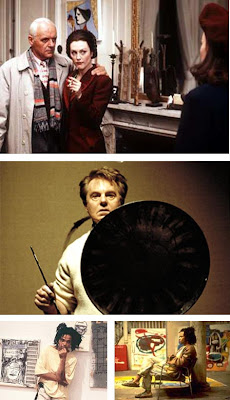
What about those movies about artists where the real artist or their estate won’t let the work be shown? It happens. To combat the problem there have been a number of approaches taken over the years. The hard-nose award goes to Surviving Picasso. Never have the backs of so many canvases been put on film. Merchant Ivory never got close to convincing Francoise Gilot to give permission to show real works and while there was a meeting with Picasso’s son Claude, it came to nothing, And so many, many canvas backs and a whole lot of made-up Picassos (some better than others) and Picasso-like objects have to stand in for the real thing. It’s all a bit weird when the movie is about an artist who was dedicated to showing off his work. The Francis Bacon movie Love is the devil had the same problem but responded with a different solution. Director John Maybury had the skill to create compositions within the film that read like Bacon paintings.
Artist and director Julian Schnabel took another tack. As we have already seen in this series, James Cameron had his own versions of Picasso run up for Titanic and this is exactly what Schnabel did for Basquiat when the Estate refused permission for any original work to appear. As you can see from the stills, Schnabel himself did a very …. er…. Schnabely version of Jean Michel’s graphic paintings and when Gary Oldman (Julian Schnabel) takes Jeffrey Wright (Basquiat) to his home, there’s the Andy Warhol portrait of Schnabel. It gets even more complicated. When Oldman (Schnabel) is seen supervising the hanging of his show at Mary Boone, Oldman borrowed Schnabel’s own pyjamas in a fit of über realism - which is as good a point as any, to stop.
Images: Top, Picasso-like products lurk in the background of Surviving Picasso. Middle, Love is the devil uses composition to evoke Bacon’s work. Bottom, Schnabel does Basquiat.
Posted by
jim and Mary
at
7:00 AM
![]()
![]()
Labels: art in the movies
Monday, July 07, 2008
Ripping yarn
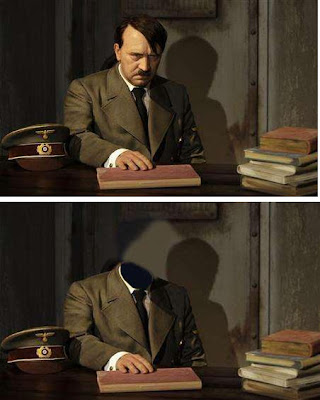
As this seems to be Sculpture Monday we should tell you about the latest sculpture scandal here in Berlin. Madame Tussauds has just opened here and one of the features in their new displays is a representation of Adolf Hitler. Not H the scourge of Europe (it is still illegal to display Nazi symbols here), but abject Adolf, moody, inward-looking and broken, a sad loser and obvious contender for immediate suicide watch. The people at Madame’s clearly thought this enfeebled Fuehrer would satisfy their critics who felt it was too early to have the Chancellor, even a wax one, back behind a desk in Berlin. As it worked out Tussauds didn’t have the Hitler feature open for long before the second visitor, a 41 year old guy, leapt over the barriers and ripped Adolf’s head off.
Image: Top, The wax Hitler meditating in his bunker. Bottom, an exclusive OTN reconstruction of the beheaded figure.
Posted by
jim and Mary
at
7:53 AM
![]()
![]()
Labels: public sculpture, wax
Weights and measures

Near where we are staying in Berlin is the romantically named Heavy Load Testing Body. Essentially it is an imposing solid cylinder of 12,360 tons of concrete set on top of a smaller cylindrical concrete base. This heavy hunk of grey matter was created to test whether the site set aside for the gigantic triumphal arch Albert Speer had on the drawing board would be able to withstand this kind of weight. As there was a settlement of only 19 inches it was all go until other matters intervened. We had another physically memorable experience with mass and weight when we saw Richard Serra’s Berlin Block for Charlie Chaplin, a cube of steel impaled, on a slight angle, into the surface of Berlin’s New National Gallery’s concrete deck. Is Richard Serra interested in weight? You might say so. “"Weight is a value for me, not that it is any more compelling than lightness, but I simply know more about weight than lightness and therefore I have more to say about it, more to say about the balancing of weight, the diminishing of weight, the addition and subtraction of weight, the concentration of weight, the rigging of weight, the propping of weight, the placement of weight, the locking of weight, the psychological effects of weight, the disorientation of weight, the disequilibrium of weight, the rotation of weight, the movement of weight, the directionality of weight, the shape of weight." (Richard Serra, 1988)
Images: Top, Heavy Load Testing Body by Albert Speer 1941. 21 meters diameter x 14 meters above ground and 18 meters below ground. Bottom, Richard Serra’s Berlin Block for Charlie Chaplin 1978
Posted by
jim and Mary
at
7:01 AM
![]()
![]()
Labels: public sculpture
Saturday, July 05, 2008
50 years ago around about now
About this time 50 years ago Colin McCahon returned from his trip to the United States and painted the Northland Panels. Chances are good that while he was over there he saw the painting Jackson Pollock is working on in this short film by Hans Namuth.
Friday, July 04, 2008
Nature study
By the sound of it, with the weather being what it is, most of our readers could do with something to bring on a smile. So, hoping Daniel won’t mind, here is a pic of his wonderful Paradise Duck snapped when Gambia Castle were in their old digs.
Image: Paradise Duck by Daniel Malone
Posted by
jim and Mary
at
11:57 AM
![]()
![]()
Faster, faster copy cat, kill, kill, kill

While we were in the Prado we came cross the ultimate Copy Cat. In fact there were about seven of them scattered throughout the collections. The curious thing was that while they were busy making their copies of the art, we were being instructed not to photograph it, even when one of the copy cats were obscuring the view. In the old days you used to hear guards say “don’t touch.” Now it’s “don’t photograph.” The classic shift of our time from object to image. But there were so many people with small cameras, phones and pda that you could feel that the guards knew they are fighting a losing battle. Even in a hyper conventional institution like the Prado you can sense the whole “No photographs” thing losing momentum.
Still, as it stands, at the Prado you can make a realistic copy of the work in oils and on canvas (as long as it is not the same size as the original), but you can’t make an image of it with a camera to print on paper or show on a screen. It must be the same feeling people had when cars were told not to use the main streets so they didn't scare the horses.
Thursday, July 03, 2008
Er, Monsieur Loyrette, do you have a moment?
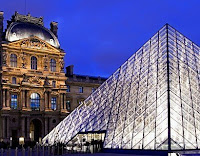
"He is one of the New Zealand artists who could hang in any museum in the world"
Richard Thomson, gallery director of the International Art Centre in Parnell, talks up C F Goldie
52 pick up
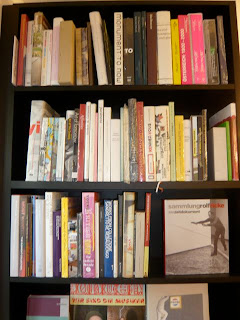
There was a short story we read once about a guy who collected playing cards. In fact he was collecting a full deck of cards with the kicker being that he could only add cards that he found randomly on the street. Over the years, one by one, he slowly assembled close to a full deck. An Ace of Spades in a gutter here, a Queen of Clubs blown into a doorway there. Years went past and he had them all, all but one card. The Seven of Diamonds. Then one morning he spotted a flash of red under a park bench, and sure enough it was the last card. He went home, added it to the deck, walked upstairs, and hung himself. Which is to explain why, after years of collecting books about private art collections (one or two a year), we weren’t as pleased as we might have been when we saw a shelve with about 100 of them at the incredible Walther König Books yesterday.
Posted by
jim and Mary
at
7:07 AM
![]()
![]()
Labels: collecting
Wednesday, July 02, 2008
Things past

The last time we were in Berlin we posted a photo of Jeff Koons’ sculpture Balloon Flower, the blue version of which is in the DaimlerChrysler collection and installed on Potsdamer Platz. A couple of days ago, in their 30 June sale, the magenta version sold at Christie’s for a record $US25.7 million. If you’re into art logistics, and who isn’t these days, here is an amusing account of how the giant sculpture was shipped in a 4.37 by 3.18 by 3.61 meter crate on a chartered Soviet military aircraft, the Antonov 124.
Posted by
jim and Mary
at
3:00 PM
![]()
![]()
Labels: things past
Flaming June
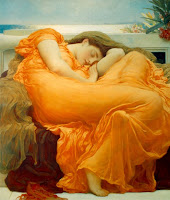
In June we listened in on people at the Basel Art Fair • spotted art trends • baulked at Brad’s taste in lamps • came up with one of our best ever post titles • went to the movies • came to understand that some dealers had bigger ones than others • announced the first of two winners in the CNZ Venice bake off • put in a plug for Francis • gave credit where credit was due • found the Duke and became emotional in Madrid .
Image: Flaming June by Frederick Leighton in the collection of the Museo de Arte de Ponce, Puerto Rico
Posted by
jim and Mary
at
11:57 AM
![]()
![]()
The 12.8 million dollar question
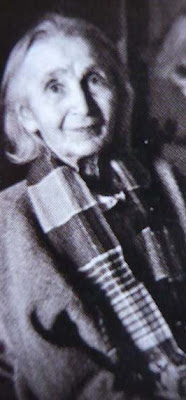 Extraordinary prices on the international art market recently are putting huge pressure on art institutions. The question is whether to sell works from the collections which are judged not essential but have become exceptionally valuable. These sales, the argument goes, provide funds that can be used to make purchases more relevant to the institution’s mission. In New Zealand deaccessioning, as it is called in the profession, is uncommon and its processes have often not been made public. The Govett-Brewster in an exception having deaccessioned a number of works over the years via an advisory committee including an impressive painting by American John McLaughlin.
Extraordinary prices on the international art market recently are putting huge pressure on art institutions. The question is whether to sell works from the collections which are judged not essential but have become exceptionally valuable. These sales, the argument goes, provide funds that can be used to make purchases more relevant to the institution’s mission. In New Zealand deaccessioning, as it is called in the profession, is uncommon and its processes have often not been made public. The Govett-Brewster in an exception having deaccessioned a number of works over the years via an advisory committee including an impressive painting by American John McLaughlin.
So consider the dilemma presented by Russian artist Natalia Goncharova to the national collections held by Te Papa. Te Papa has seven works by Goncharova. Three of them came into the collection in 1973 via Alexandra Larionov who Goncharova's companion and fellow artist Mikhail Larionov married after Goncharova's death. Ten years later another four paintings were gifted by the National Art Gallery’s London agent Mary Chamot.
Apart from Porteuse de raisins (Woman carrying fruit on her head) from 1911, which has been shown off and on over the years, most of the Goncharova paintings have spent most of their time in store. That in itself is not so newsworthy but the huge escalation in value of these works over the last couple of years certainly is. A group of vastly rich Russian men (they all seem to be men, most of them “bankers”) have shaken up the global art market showing a particular interest in contemporary Russian art and work produced early in the twentieth century. Recent auction prices show the depth of their oligarchic pockets.
Goncharova’s Picking apples, a painting made a couple of years before Te Papa’s Porteuse de raisins, achieved $NZ12.8 million last June at auction. More recently a semi-abstract work titled Bluebells, another 1909 work, was sold for $NZ8.1 million. Last week at Christie's these prices were held when her 1912 painting, Les Fleurs sold for $NZ14.5 million. Serious money. Of course it’s hard to know how much Te Papa’s works might bring (for some reason non of these paintings are illustrated in Te Papa’s database) but it's going to be more than chump change.
So here’s a question. Now that Te Papa no longer collects or shows much concern for international art, how important are the Goncharovas to the collection? Is having them on the racks in store enough of a reason to hold on to them, given their new escalated values?
Museums around the world (from MoMA down) sell works to buy more relevant examples, new work, or to build up interest-bearing funds for future purchases. Now the extreme auction prices for Goncharova brings this challenge to the doors of Te Papa. At the very least it's worth a discussion.
Image: Natalia Goncharova looking disarmingly like Rita Angas
Posted by
jim and Mary
at
7:00 AM
![]()
![]()
Labels: collecting, numbers, Te papa
Tuesday, July 01, 2008
Big, bigger, biggest

The UK is continuing in its determination to be home to the world’s tallest sculptures. The latest addition dwarfs Gormley’s The Angel of the North by three times and makes the Statue of Liberty look like a doll holding a lamp and a book. Designed by architect Ken Shuttleworth (aka by his friends as, “Ken the Pen”) as a destination attraction, Aspire is a 60 metre tower commissioned by Nottingham University. The benefactor has [insert your own reason here] remained anonymous. We’ve already posted on the UK’s response to Sweedish attempts to snatch the world’s tallest animal sculpture in the form of a colossal moose. We will give you giant horse reports from the UK as they come to hand.
Posted by
jim and Mary
at
11:57 AM
![]()
![]()
Labels: public sculpture
Sculpture cam
Here's something you don't get to do every day - film a sculpture from a bike. The work is Richard Serra's Berlin Junction which although it appears kind of uncared for is typically impressive. It stands outside the Berlin Philharmonic's building - you can see it in the center of the image below via Google Earth, an entertaining way to look at art we were pointed to by Andrew Clifford's site Art from Space.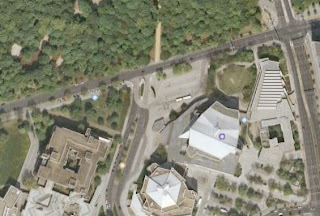
Posted by
jim and Mary
at
7:00 AM
![]()
![]()
Labels: public sculpture






